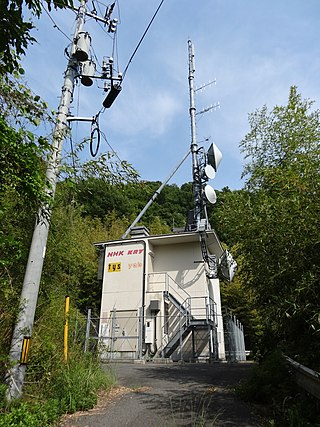Related Research Articles
FM broadcasting in the United States began in the 1930s at engineer and inventor Edwin Howard Armstrong's experimental station, W2XMN. The use of FM radio has been associated with higher sound quality in music radio.

Very high frequency (VHF) is the ITU designation for the range of radio frequency electromagnetic waves from 30 to 300 megahertz (MHz), with corresponding wavelengths of ten meters to one meter. Frequencies immediately below VHF are denoted high frequency (HF), and the next higher frequencies are known as ultra high frequency (UHF).

Low-power broadcasting is broadcasting by a broadcast station at a low transmitter power output to a smaller service area than "full power" stations within the same region. It is often distinguished from "micropower broadcasting" and broadcast translators. LPAM, LPFM and LPTV are in various levels of use across the world, varying widely based on the laws and their enforcement.

The FM broadcast band is a range of radio frequencies used for FM broadcasting by radio stations. The range of frequencies used differs between different parts of the world. In Europe and Africa and in Australia and New Zealand, it spans from 87.5 to 108 megahertz (MHz) - also known as VHF Band II - while in the Americas it ranges from 88 to 108 MHz. The FM broadcast band in Japan uses 76 to 95 MHz, and in Brazil, 76 to 108 MHz. The International Radio and Television Organisation (OIRT) band in Eastern Europe is from 65.9 to 74.0 MHz, although these countries now primarily use the 87.5 to 108 MHz band, as in the case of Russia. Some other countries have already discontinued the OIRT band and have changed to the 87.5 to 108 MHz band.
Station identification is the practice of radio and television stations and networks identifying themselves on-air, typically by means of a call sign or brand name. This may be to satisfy requirements of licensing authorities, a form of branding, or a combination of both. As such, it is closely related to production logos, used in television and cinema alike.
In North American broadcast television frequencies, channel 1 was a former broadcast (over-the-air) television channel which was removed from service in 1948.

FM broadcasting is the method of radio broadcasting that uses frequency modulation (FM). Invented in 1933 by American engineer Edwin Armstrong, wide-band FM is used worldwide to transmit high-fidelity sound over broadcast radio. FM broadcasting offers higher fidelity—more accurate reproduction of the original program sound—than other broadcasting techniques, such as AM broadcasting. It is also less susceptible to common forms of interference, having less static and popping sounds than are often heard on AM. Therefore, FM is used for most broadcasts of music and general audio. FM radio stations use the very high frequency range of radio frequencies.

WWRI is a radio station licensed to West Warwick, Rhode Island, and serving the Providence metropolitan area. The station is owned by Chris DiPaola, through licensee DiPonti Communications, LLC, and broadcasts a classic rock radio format.
Apex radio stations was the name commonly given to a short-lived group of United States broadcasting stations, which were used to evaluate transmitting on frequencies that were much higher than the ones used by standard amplitude modulation (AM) and shortwave stations. Their name came from the tall height of their transmitter antennas, which were needed because coverage was primarily limited to local line-of-sight distances. These stations were assigned to what at the time were described as "ultra-high shortwave" frequencies, between roughly 25 and 44 MHz. They employed amplitude modulation (AM) transmissions, although in most cases using a wider bandwidth than standard broadcast band AM stations, in order to provide high fidelity sound with less static and distortion.
WTSS is a commercial radio station in Buffalo, New York, branded as Star 102.5. It airs a hot adult contemporary radio format, switching to Christmas music for much of November and December. It is owned and operated by Audacy, Inc. The studios and offices are on Corporate Parkway in Amherst, New York.
Band I is a range of radio frequencies within the very high frequency (VHF) part of the electromagnetic spectrum. The first time there was defined "for simplicity" in Annex 1 of "Final acts of the European Broadcasting Conference in the VHF and UHF bands - Stockholm, 1961". Band I ranges from 47 to 68 MHz for the European Broadcasting Area, and from 54 to 88 MHz for the Americas and it is primarily used for television broadcasting in compliance with ITU Radio Regulations. With the transition to digital TV, most Band I transmitters have already been switched off.
KNIK-LP is a low-power television station in Anchorage, Alaska, United States, which is currently silent. The station was one of very few low-power television stations that operated predominantly as a radio station by way of the fact that many FM radio receivers can tune in a VHF channel 6 television audio carrier at 87.75 MHz. This technique is made more potent due to a formerly unforeseen interpretation of deregulatory language in FCC low-power television station regulations:
Sec. 73.653 Operation of TV aural and visual transmitters.
The aural and visual transmitters may be operated independently of each other or, if operated simultaneously, may be used with different and unrelated program material.

A broadcast relay station, also known as a satellite station, relay transmitter, broadcast translator (U.S.), re-broadcaster (Canada), repeater or complementary station (Mexico), is a broadcast transmitter which repeats the signal of a radio or television station to an area not covered by the originating station. It expands the broadcast range of a television or radio station beyond the primary signal's original coverage or improves service in the original coverage area. The stations may be used to create a single-frequency network. They may also be used by an AM or FM radio station to establish a presence on the other band.
The following radio stations broadcast on FM frequency 87.9 MHz:
W275BK is a radio station translator in Decatur, Georgia. Owned by Urban One, the station simulcasts an urban oldies music format branded as Classix 102.9, as a relay from HD Radio subchannel WAMJ-HD2 in Roswell, Georgia. WAMJ-HD2 is also simulcast on HD Radio subchannel WUMJ-HD2 in Fayetteville, Georgia.
This is a list of low-power television stations (LPTV) in the United States, transmitting on VHF channel 6, which operate as radio stations capable of being picked up by standard FM receivers. These stations are colloquially known as "Franken FMs", a reference to Frankenstein's monster, because TV stations functioning as radio stations had not been envisioned by the Federal Communications Commission (FCC). The FCC commonly refers to these stations as "FM6" operations.

UHF television broadcasting is the use of ultra high frequency (UHF) radio for over-the-air transmission of television signals. UHF frequencies are used for both analog and digital television broadcasts. UHF channels are typically given higher channel numbers, like the US arrangement with VHF channels (initially) 1 to 13, and UHF channels (initially) numbered 14 to 83. Compared with an equivalent VHF television transmitter, to cover the same geographic area with a UHF transmitter requires a higher effective radiated power, implying a more powerful transmitter or a more complex antenna. However, the additional channels allow more broadcasters in a given region without causing objectionable mutual interference.
The Pan-American television frequencies are different for terrestrial and cable television systems. Terrestrial television channels are divided into two bands: the VHF band which comprises channels 2 through 13 and occupies frequencies between 54 and 216 MHz, and the UHF band, which comprises channels 14 through 36 and occupies frequencies between 470 and 700 MHz. These bands are different enough in frequency that they often require separate antennas to receive, and separate tuning controls on the television set. The VHF band is further divided into two frequency ranges: VHF low band between 54 and 88 MHz, containing channels 2 through 6, and VHF high band between 174 and 216 MHz, containing channels 7 through 13. The wide spacing between these frequency bands is responsible for the complicated design of rooftop TV antennas. The UHF band has higher noise and greater attenuation, so higher gain antennas are often required for UHF.
Call signs in the United States are identifiers assigned to radio and television stations, which are issued by the Federal Communications Commission (FCC) and, in the case of most government stations, the National Telecommunications and Information Administration (NTIA). They consist of from 3 to 9 letters and digits, with their composition determined by a station's service category. By international agreement, all call signs starting with the letters K, N and W, as well as AAA-ALZ, are reserved exclusively for use in the United States.
References
- ↑ "Why Do FM Frequencies End in an Odd Decimal?" (fcc.gov)
- ↑ "FCC Adopts FM Set Numbering System", Broadcasting, November 19, 1945, page 4.
- ↑ "FCC moves to overhaul rules for noncommercial radio and TV", Broadcasting, June 12, 1978, page 50.